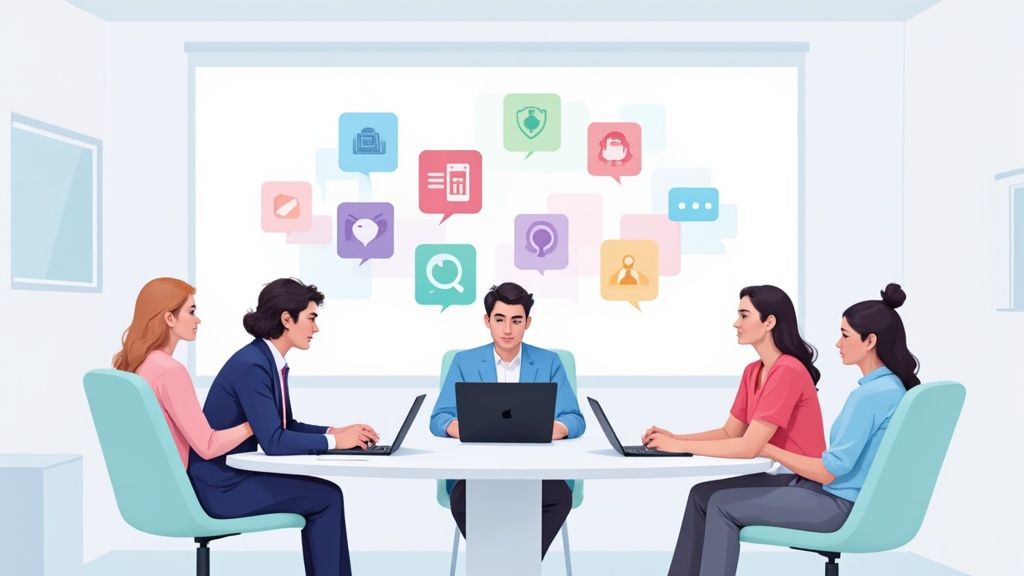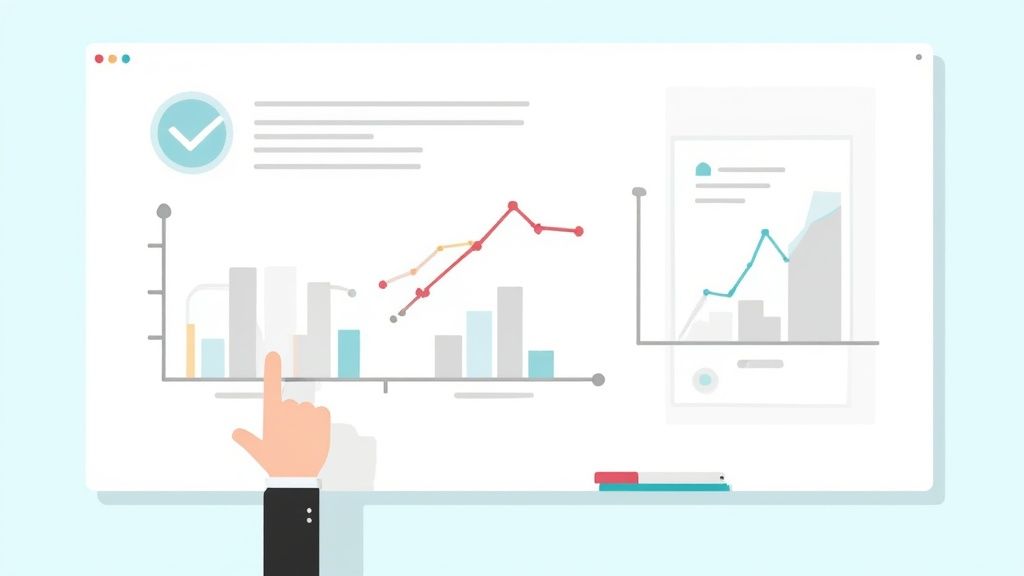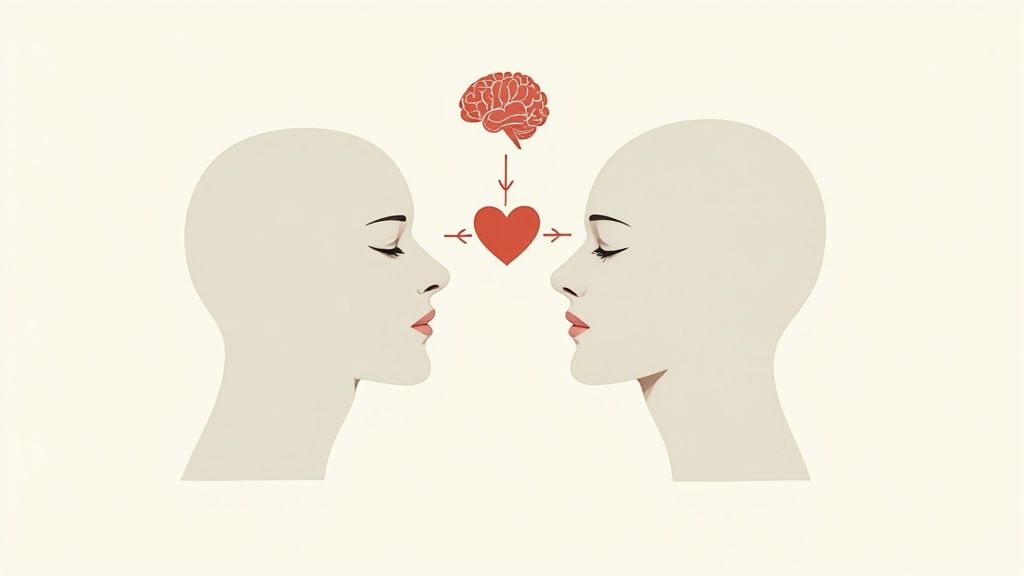Blog

8 Effective Ways to Improve Workplace Communication in 2025
By BeThere
Oct 1, 2025 • 17 min read

Effective communication is the lifeblood of any successful organization. It's the invisible thread that connects teams, fuels innovation, and builds a culture where everyone feels valued and understood. When channels are clear, projects move forward, collaboration thrives, and employee engagement soars. In today's hybrid and remote work landscapes, however, maintaining this clarity has become more challenging than ever. Misunderstandings multiply, vital information gets lost in a sea of notifications, and team cohesion can suffer.
This guide offers more than just generic advice; it provides a roadmap with eight concrete, actionable ways to improve workplace communication, transforming your team's interactions from confusing to crystal-clear. We will explore proven strategies, from fostering a culture of open feedback to leveraging the right tools for the job. For teams that live in Slack and Google Calendar, coordinating these efforts can feel fragmented, but it doesn’t have to be. Tools like Be-There.co are specifically designed for this ecosystem, streamlining event and meeting management directly within your existing workflow to bridge that gap. For a comprehensive guide on fostering better dialogue and overall effectiveness, explore these tips to improve workplace communication. Let’s dive into the methods that will elevate your team's communication game and boost productivity.
1. Implement Regular One-on-One Meetings
Regular one-on-one meetings are dedicated, recurring conversations between a manager and a direct report. Far from being simple status updates, these sessions are a cornerstone for building trust, providing personalized feedback, and aligning individual goals with company objectives. This approach, famously championed by Intel’s Andy Grove, transforms communication from a reactive, task-based exchange into a proactive, development-focused partnership.

When managers consistently make time for these conversations, they create a safe space for employees to share concerns, discuss career aspirations, and overcome obstacles. This dedicated attention is one of the most effective ways to improve workplace communication, leading to higher engagement and retention. Companies like Microsoft and Netflix have built strong feedback cultures on the foundation of frequent, candid one-on-one meetings.
✦How to Make One-on-Ones Effective
To get the most out of these meetings, follow a structured yet flexible approach:
- Empower Your Team: Let the employee set at least half of the agenda. This ensures their most pressing topics are addressed and gives them ownership of the conversation.
- Focus on the Future: While it's fine to touch on past performance, dedicate most of the time to development, upcoming challenges, and career growth.
- Ask Open-Ended Questions: Move beyond "How's it going?" Ask questions like, "What part of your work is most energizing right now?" or "What’s one thing we could change to make your job easier?"
- Maintain Consistency: Scheduling is key. For any company using both Slack and Google Calendar, this can become a hassle. A tool like BeThere is incredibly handy here. It integrates natively with both platforms, allowing you to easily set up recurring events, send automated reminders, and ensure these critical meetings are never missed, all without leaving Slack. This streamlines the administrative work so you can focus on the conversation.
2. Establish Clear Communication Channels and Protocols
Establishing clear communication channels means creating a defined system for how, where, and when information is shared. Instead of a free-for-all where urgent news gets lost in a sea of casual chat, this approach designates specific tools for specific purposes. This clarity is crucial for reducing digital noise, preventing important messages from being missed, and ensuring everyone knows the right place to find or share information.
This systematic approach, championed by leaders like Stewart Butterfield of Slack and Jason Fried of Basecamp, is a cornerstone of effective modern work, especially in remote or hybrid environments. When employees know whether to send an email, post in a specific Slack channel, or add a comment to a project board, they can communicate with more confidence and efficiency. This simple organization is one of the most impactful ways to improve workplace communication, leading to faster response times and less frustration.
✦How to Implement Clear Channels and Protocols
To build a more organized communication ecosystem, follow these practical steps:
- Create a Communication Charter: Develop a simple document outlining which tool to use for which purpose. For example: Email for formal external communication, Slack for real-time internal collaboration, and a project management tool for task updates.
- Define Urgency Levels: Set clear expectations for different types of messages. Use tags like
[URGENT]or dedicated channels for time-sensitive issues, so team members know what needs immediate attention. - Set Response Time Expectations: Clarify expected response times for different channels. A message in a
_socialchannel might not need a reply, while a direct message may require one within a few hours. This helps manage expectations and reduces anxiety. For more strategies, you can explore these internal communication best practices. - Train Your Team: Don't just create the rules; actively onboard everyone. Regularly remind team members of the protocols and guide them when they use the wrong channel. Consistency is key to making the system work.
3. Practice Active Listening Techniques
Active listening is a communication skill that involves fully concentrating on, understanding, and responding to what is being said. More than just hearing words, it's about grasping the complete message, including emotional undertones and non-verbal cues. This approach, heavily influenced by psychologists like Carl Rogers and Stephen Covey’s principle to "seek first to understand," is fundamental to creating psychological safety and trust in the workplace.
When team members feel genuinely heard, collaboration flourishes, and misunderstandings diminish. This is one of the most powerful ways to improve workplace communication because it validates the speaker's perspective, fostering a culture of respect. Companies like Salesforce build their "Ohana" culture on these principles, and Southwest Airlines integrates active listening into their renowned customer service training, proving its impact on both internal morale and external success.
✦How to Practice Active Listening Effectively
To build this skill within your team, encourage these simple yet powerful habits:
- Eliminate Distractions: Put away phones, close unnecessary tabs, and give the speaker your undivided attention. This signals respect and focus.
- Show Engagement: Use positive body language like maintaining eye contact, nodding, and leaning in slightly to show you are present and invested in the conversation.
- Paraphrase and Clarify: Repeat back what you heard in your own words, starting with phrases like, "So, if I'm understanding correctly..." or "What I'm hearing is..." This confirms comprehension.
- Ask Open-Ended Questions: Go beyond simple yes/no questions. Ask "How did that impact the project?" or "What are your thoughts on the next steps?" to encourage deeper dialogue.
- Acknowledge Emotions: Validate feelings by saying, "It sounds like that was a frustrating experience." This shows empathy and builds a stronger connection, making colleagues feel understood.
4. Encourage Open Feedback Culture
An open feedback culture is an environment where giving and receiving feedback is normalized, valued, and practiced regularly at all levels. It moves beyond dreaded annual reviews, transforming feedback into an ongoing dialogue focused on continuous improvement and psychological safety. This approach, famously championed by leaders like Kim Scott with 'Radical Candor', treats feedback as a gift for growth rather than a tool for criticism.
When organizations successfully build this culture, they create powerful systems for growth and alignment. It’s one of the most transformative ways to improve workplace communication because it builds trust and empowers individuals to perform at their best. Companies like Netflix and Bridgewater Associates have built their success on principles of radical transparency and candid feedback, demonstrating its profound impact on innovation and performance. Building this culture also aligns with principles from social learning theory, where employees observe and model constructive communication behaviors from leadership.
✦How to Foster an Open Feedback Culture
To effectively build a culture of feedback, you need to create clear, consistent, and safe processes:
- Model the Behavior: Leaders must lead by example. Actively ask for feedback on your own performance and receive it gracefully. This shows the team that feedback is a valuable tool for everyone, not just a top-down directive.
- Use a Simple Framework: Introduce an easy-to-remember model like SBI (Situation-Behavior-Impact). This structure helps people deliver clear, objective, and actionable feedback by focusing on specific events and their outcomes, not personal traits.
- Make it a Habit: Create dedicated times for feedback. This could be in one-on-ones, team retrospectives, or even dedicated feedback sessions. For companies running on Slack and Google Calendar, a tool like BeThere is incredibly useful for scheduling these recurring events without context switching. It helps ensure feedback sessions become a consistent part of your team's routine by managing invites and calendars natively in Slack.
- Start with Positive Reinforcement: Begin by encouraging positive feedback and recognition. This helps build the psychological safety needed for team members to feel comfortable later sharing constructive criticism. To see how this fits into a broader plan, you can explore other internal communication strategy examples.
5. Use Visual Communication Tools and Methods
Visual communication uses elements like charts, diagrams, infographics, and collaborative whiteboards to convey information more effectively than text alone. Our brains process visuals 60,000 times faster than text, making these tools essential for improving comprehension, retention, and engagement. This method, popularized by experts like Edward Tufte and Nancy Duarte, transforms complex data and ideas into easily digestible insights.

By integrating visual aids, companies can cut through the noise of constant text-based messages and ensure critical information stands out. This approach is one of the most powerful ways to improve workplace communication, especially in data-driven or creative environments. For example, Tesla uses visual dashboards for real-time manufacturing metrics, while Spotify uses visual boards for sprint planning, making project statuses clear and accessible to everyone at a glance.
✦How to Use Visuals Effectively
To maximize the impact of visual communication, follow these best practices:
- Choose the Right Format: Use charts for data trends, diagrams for processes, and infographics for summarizing complex topics. Match the visual to the message you want to convey.
- Keep It Simple: Avoid clutter. A good visual focuses on a single key message and eliminates distracting elements. The goal is clarity, not artistic complexity.
- Maintain Brand Consistency: Use consistent colors, fonts, and logos to reinforce your brand identity and make your communications instantly recognizable and professional.
- Ensure Accessibility: Make your visuals inclusive by using high-contrast colors and adding descriptive alt-text for screen readers, ensuring everyone can access the information.
6. Implement Structured Team Meetings with Clear Agendas
Structured team meetings are organized gatherings that follow a predetermined format, timeline, and set of topics. Unlike unstructured, free-flowing conversations, these meetings are designed to maximize productivity by ensuring every participant arrives prepared and contributes meaningfully. This deliberate approach transforms meetings from notorious time-wasters into powerful engines for collaboration, decision-making, and alignment.
This method is one of the most impactful ways to improve workplace communication because it brings clarity and purpose to group interactions. Companies like Amazon, with Jeff Bezos's famous narrative-driven memo format, and Shopify, with its "no agenda, no meeting" policy, have demonstrated how structure eliminates ambiguity and fosters focused discussions. By setting clear expectations, teams can achieve more in less time.
✦How to Make Team Meetings Effective
To get the most out of your team gatherings, adopt a systematic and disciplined approach:
- Distribute Agendas in Advance: Send a clear agenda with defined objectives 24-48 hours before the meeting. This gives everyone time to prepare their thoughts and contributions.
- Assign Time Blocks: Allocate a specific amount of time to each agenda item and stick to it. This practice respects everyone's schedule and keeps the conversation on track.
- Define Clear Action Items: End every meeting by summarizing the key decisions and assigning action items with specific owners and deadlines. This ensures accountability and follow-through.
- Streamline Scheduling and Follow-Up: Use a dedicated tool to manage the process. For companies that rely heavily on both Slack and Google Calendar, BeThere is an essential utility. It simplifies creating recurring meetings, attaching agendas, and sending automated reminders directly from Slack, which then syncs with Google Calendar. This integration is incredibly handy, removing administrative friction and allowing you to concentrate on leading a productive conversation. You can learn more about how to run effective meetings to further refine your approach.
7. Develop Emotional Intelligence and Empathy Skills
Emotional intelligence (EI) is the ability to recognize, understand, and manage your own emotions while also recognizing, understanding, and influencing the emotions of others. Popularized by Daniel Goleman, this skill set is a critical component of effective workplace communication. It moves interactions beyond the purely transactional, fostering stronger relationships, better conflict resolution, and a more positive and collaborative culture.

When team members and leaders possess high EI, they can navigate complex social dynamics with greater ease and empathy. This leads to more thoughtful feedback, improved teamwork, and higher psychological safety. Companies like Johnson & Johnson and L'Oréal have made EI a cornerstone of their leadership development programs, recognizing its direct impact on performance and a key way to improve workplace communication.
✦How to Cultivate Emotional Intelligence
Building EI is an ongoing practice that requires self-awareness and intentional effort. Here are a few actionable steps to get started:
- Practice Active Listening: Go beyond simply hearing words. Pay close attention to non-verbal cues like body language and tone of voice to understand the full emotional context of a message.
- Encourage Perspective-Taking: Before reacting in a tense situation, pause and try to see the situation from the other person’s point of view. Ask clarifying questions like, "Can you help me understand your perspective on this?"
- Name and Manage Emotions: Improve self-awareness by learning to identify your specific emotional state (e.g., frustrated, anxious, excited). This is the first step toward self-regulation and preventing reactive responses.
- Seek Constructive Feedback: Ask trusted colleagues or your manager for feedback on your communication style and emotional impact. Be open to hearing how your actions are perceived by others.
8. Create Documentation and Knowledge Sharing Systems
Documentation and knowledge sharing systems are centralized repositories for an organization's crucial information, including processes, decisions, and best practices. Instead of allowing valuable knowledge to exist only in individuals' minds or scattered across chat threads, these systems capture and organize it for everyone. This approach is a powerful way to improve workplace communication by creating a single source of truth that reduces repetitive questions and streamlines workflows.
When teams commit to documenting their work, they build institutional memory that outlasts any single employee’s tenure. This practice empowers team members to find answers independently, accelerates onboarding for new hires, and ensures consistency across the organization. Companies like GitLab, with its comprehensive public handbook, and Atlassian, with its Confluence-driven internal wikis, demonstrate how a documentation-first culture promotes transparency and efficiency.
✦How to Build an Effective Knowledge Base
To create a system that your team actually uses, focus on accessibility and maintenance:
- Start Small and Scale: Begin by documenting frequently asked questions and common processes. This provides immediate value and builds momentum for more extensive documentation efforts.
- Standardize with Templates: Use templates for meeting notes, project plans, and process guides. This consistency makes it easier for team members to both contribute and find information.
- Integrate Documentation into Workflows: Make updating documentation a required step in your project completion checklists. This ensures that knowledge is captured as work is finished, not as an afterthought.
- Schedule Regular Reviews: Assign ownership for different sections of your knowledge base and schedule regular reviews to keep content accurate and relevant. Outdated information is often worse than no information at all.
8 Strategies for Improving Workplace Communication Comparison
| Item | Implementation Complexity 🔄 | Resource Requirements ⚡ | Expected Outcomes 📊 | Ideal Use Cases 💡 | Key Advantages ⭐ |
|---|---|---|---|---|---|
| Implement Regular One-on-One Meetings | Medium - requires scheduling & commitment | Moderate - manager time and preparation | Improved engagement, retention, personalized development | Teams needing strong manager-employee rapport | Builds trust, early issue detection, tailored growth |
| Establish Clear Communication Channels and Protocols | High - setup platforms & train employees | High - tools, training, integration | Reduced confusion, faster responses, efficient workflows | Hybrid/remote teams, complex org communication | Clarifies usage, reduces overload, enhances accountability |
| Practice Active Listening Techniques | Medium - skill development & consistent focus | Low - mainly cognitive effort | Stronger trust, fewer conflicts, increased inclusion | Any communication-heavy roles | Builds trust, reduces misunderstandings, fosters safety |
| Encourage Open Feedback Culture | High - cultural change, ongoing management | Moderate - training, frameworks | Accelerated growth, innovation, stronger relationships | Growth-oriented organizations | Improves performance, builds trust, reduces gossip |
| Use Visual Communication Tools and Methods | Medium - requires tools and design skills | Moderate - design tools and time investment | Better comprehension, retention, engagement | Data-heavy communication, complex concepts | Enhances clarity, breaks barriers, improves decisions |
| Implement Structured Team Meetings with Clear Agendas | Medium - planning & discipline required | Low to moderate - prep time per meeting | Increased productivity, accountability, engagement | Frequent team syncs, project coordination | Saves time, ensures coverage, reduces meeting fatigue |
| Develop Emotional Intelligence and Empathy Skills | High - long-term personal development | Low to moderate - training and practice | Better conflict resolution, leadership, team cohesion | Leadership roles, interpersonal heavy roles | Improves relationships, reduces stress, enhances influence |
| Create Documentation and Knowledge Sharing Systems | High - initial setup & ongoing maintenance | High - platform costs, content creation | Preserved knowledge, improved onboarding, reduced repeat queries | Large or distributed teams, knowledge-critical areas | Prevents knowledge loss, improves consistency, supports remote work |
Unify Your Team Communication: The Be There Advantage
Throughout this guide, we've explored a comprehensive toolkit of strategies to elevate your team's dialogue, from fostering an open feedback culture to mastering the art of active listening. We’ve established that great communication isn’t a single action but a sustained, intentional effort built on clear protocols, genuine empathy, and consistent practice. Implementing regular one-on-one meetings, creating robust knowledge-sharing systems, and running structured team meetings are not just tasks to check off a list. They are the foundational pillars of a collaborative, efficient, and engaged workplace.
Mastering these ways to improve workplace communication transforms an organization from a collection of individuals into a cohesive, high-performing unit. When channels are clear, feedback is constructive, and every team member feels heard and understood, the benefits are profound. You'll see a direct impact on project outcomes, a noticeable boost in employee morale, and a significant reduction in the misunderstandings that lead to friction and wasted time. The core takeaway is that communication is the engine of your company culture and its operational success.
✦Bridging the Gap Between Strategy and Execution
While cultivating these habits is essential, the logistical challenges of bringing people together can be a significant hurdle, especially for hybrid and remote teams that rely on Slack and Google Calendar. How do you schedule a workshop, organize a team-building event, or coordinate a critical meeting without getting lost in a sea of calendar conflicts and manual follow-ups? This is where strategic tools become a game-changer.
The most effective communication strategies are those that are easy to implement. For companies that operate within Slack and Google Calendar, the administrative burden of event coordination can ironically undermine the very connection you’re trying to build. The back-and-forth of finding a time, sending invites, tracking RSVPs, and issuing reminders is fragmented and time-consuming.
This is precisely the gap that Be There was designed to fill. It is an incredibly useful and handy tool for any company using Slack and Google Calendar internally. As the first native event planner built for Slack, it seamlessly integrates with Google Calendar to eliminate this friction. Imagine announcing a new training session directly in a Slack channel. With a simple command, you can create the event, have it automatically populate everyone’s Google Calendar, and let Be There handle the RSVPs and reminders. It transforms the tedious task of coordination into a streamlined, one-step process. By simplifying logistics, you empower your team to focus on the quality of the interaction, not the administrative chaos behind it. It ensures that your efforts to improve workplace communication are supported by technology that brings people together, effortlessly.
Ready to spend less time coordinating and more time connecting? See how Be There can streamline your event management directly within Slack and Google Calendar. Visit Be There to simplify your scheduling and enhance your team’s engagement today.

Planning your internal events has never been easier!
No more scheduling headaches—our Slack-connected web app keeps things simple. Less email, more fun! 🚀